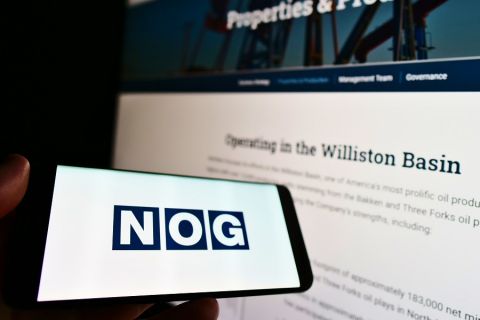
(Source: Shutterstock, Hart Energy)
The Permian Basin’s burgeoning natural gas output is muscling its way into markets that have been dominated by other plays, threatening to dent growth aspirations in Appalachia and the Haynesville Shale by 2020, an OPIS analyst said during a recent webinar.
The culprit is associated gas, which accounted for 7% of the U.S. gas market in 2011 and will command a 30% share in 2020, said Charles Nevle, senior director of OPIS (Oil Price Information Service), a unit of IHS Markit. Associated gas also made up about two-thirds of the growth in total natural gas production between 2011 and 2018.
The impact on other regions like Appalachia begins with constraints in the Permian Basin.
“Currently, oil production in the Permian, and thus associated gas, is being restricted by infrastructure constraints and what we will call forced capital discipline,” Nevle said. The capital discipline is enforced by Wall Street pressuring public companies to not just live within cash flow but actually return cash to investors. It is a concept foreign to the E&P sector in the past.
“That is having a somewhat dampening effect on what production would otherwise be in the traditional grow-as-much-as-you-can mode,” he said.
Infrastructure constraints, at least, will continue to be mitigated. Kinder Morgan Inc.’s (NYSE: KMI) Gulf Coast Express Pipeline will move 1.9 billion cubic feet per day (Bcf/d) from the Permian Agua Dulce market when it fully ramps up after going online this year. Capital discipline among producers, however, is another matter.
“How long will that be with us? We’ll see,” Nevle said. “What really needs to end up happening is not only do operators have to be disciplined enough to continue the framework they’re operating under but we would expect that they would have to be rewarded by Wall Street for their discipline in order to continue that current mentality.”
In the meantime, the growing volumes of gas need a place to go. A map might show the oil- and gas-rich areas of the Permian to be somewhat amoeba-like in shape, but OPIS simplifies that image to a four-sided box containing 10 Bcf/d of capacity eager to get out.
The directions present various challenges:
West
In this scenario, a Permian producer would load gas onto the El Paso Pipeline to move it out to the California market. It’s a big market, but Permian gas would face competition from the Rockies and Canada. That market is also moving aggressively toward renewable sources.
“In terms of an overall growth market, where you want to go to build a new pipeline with sizable incremental molecules from the Permian, heading west is really just not an attractive path to go,” Nevle said.
South
The growing Mexican market seems like a good option, except that three major pipelines—ONEOK’s Roadrunner, and Energy Transfer’s Comanche Trail and Trans-Pecos pipelines—already comprise 3.1 Bcf/d of capacity heading in that direction.
Then there are the infrastructure issues on the Mexican side of the border. Not just connecting pipelines but power plants need to be built before that market can realize its promise.
North
Sure, if you like company. Natural gas is moving toward the Midcontinent from every direction, including Canada, the Northeast and the Rockies. And that’s not including the Midcontinent itself. Oklahoma’s Scoop and Stack plays are experiencing growth in associated gas.
East
Intrastate pipelines take Permian gas to the Dallas-Fort Worth and Houston markets but the real prize is on the Gulf Coast and the ability to access the large and growing LNG export opportunities.
“If you’re going to grow a sizeable amount of Permian production, you need a market to send it to and heading towards the Gulf Coast is, by default, a way to get out of that region,” Nevle said.
Until pipelines are operational later this year, Permian gas will remain at a significant discount to the U.S. benchmark Henry Hub price. But that’s not the only destination for Permian gas.
In 2018, bucking the trend for the last several years, natural gas shipments from Texas to the Southeast rose. That increase came at the expense of the Marcellus and Utica shale plays of the Northeast.
“All that production growth out of the Permian is making Texas so much larger and longer that it’s having to push gas into the Southeast market competing and actually pushing back on that gas coming in from the Northeast,” he said. “The Northeast is now sending much more of its gas over to the Midcon market.”
It’s a flow pattern that is significantly different than that seen in the past, Nevle said, and could foreshadow market responses to expanding gas production.
Recommended Reading
Northern Oil and Gas Ups Dividend 18%, Updates Hedging
2024-02-09 - Northern Oil and Gas, which recently closed acquisitions in the Utica Shale and Delaware Basin, announced a $0.40 per share dividend.
Viper Energy Announces Pricing of Diamondback’s Secondary Common Stock Offering
2024-03-06 - Viper Energy will not receive any of the gross proceeds from Diamondback’s secondary offering of its Class A common stock.
TPG Adds Lebovitz as Head of Infrastructure for Climate Investing Platform
2024-02-07 - TPG Rise Climate was launched in 2021 to make investments across asset classes in climate solutions globally.
BP Pursues ‘25-by-‘25’ Target to Amp Up LNG Production
2024-02-15 - BP wants to boost its LNG portfolio to 25 mtpa by 2025 under a plan dubbed “25-by-25,” upping its portfolio by 9% compared to 2023, CEO Murray Auchincloss said during the company’s webcast with analysts.
Kimmeridge Fast Forwards on SilverBow with Takeover Bid
2024-03-13 - Investment firm Kimmeridge Energy Management, which first asked for additional SilverBow Resources board seats, has followed up with a buyout offer. A deal would make a nearly 1 Bcfe/d Eagle Ford pureplay.






